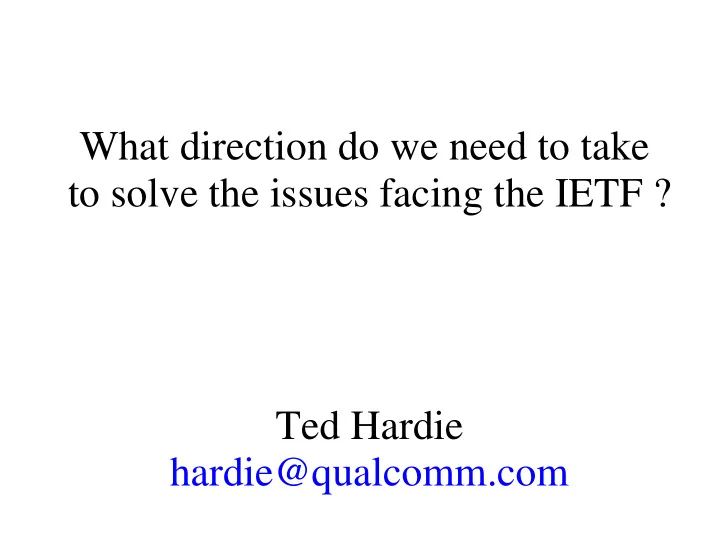

What direction do we need to take to solve the issues facing the IETF ? Ted Hardie hardie@qualcomm.com
� � � ✁ ✁ Types of Work Some small, short term efforts Some longer term changes to how IETF participants see and do their work All meant to fit within the current scope and mission of the IETF The effort to describe the IETF's mission was not intended to introduce change, just to meet the need for a “touchstone” for what the IETF does No truth to the rumors about impending IETF song
� � � Functional differentiation At this moment, there are a number of roles and responsibilities that fall to the same set of people By differentiating those roles, we can make it possible to spread the load without greatly increasing the amount of time that must be spent in the organizational equivalent of inter-process communication Allows us to get more “feet on the street” without increasing the risk of running into each other
✁ � ✁ ✁ � ✁ ✁ � Examples of functional differentiation EDU Team Intended to create a team focused on developing materials and preparing presentations Obvious connections to other Internet engineering work, but different skills needed AdvComm recommendations Differentiate business management from other roles related to Internet engineering Though there are connections, day to day management need not be the same Split of Info/Experimental Review One proposal is to split review of standards from info/experimental drafts from RFC-Editor
✁ � ✁ � ✁ � � ✁ ✁ Core Value: Cross-Functional Review Critical part of the IETF's value and value system Some docs say that individuals participate in the IETF by participating in its working groups There is a level of involvement beyond that: IETF last call the cross-area review of the IESG WG "tourism" Critical that it be an overt shift Because it has to compete with WG tasks Because we have to persuade employers to pay for it
� � � For example proposals on cross- functional review, see Alex's Talk Note, though, that all of these proposals: CARD, CREW, ART, 2-Level, etc., are inspired by informal structures that are already there Aiming to strengthen and formalize a value that is already a key part of our shared understanding of the IETF Aimed at getting consistent process for milestone reviews that will help ensure consistent results
� � ✁ ✁ Matching authority and responsibility As new roles are created or change, we have to make sure that the authority and responsibility match Primary example right now is the Working Group Chair's role Margaret will discuss a proposed update to RFC 2418 intended to ensure these two match for this role The key updates would make sure Working Group chairs are responsible for the document quality of their groups, and make sure they have the authority to match that responsibility
� � ✁ � ✁ ✁ Associate Activity with named individuals (and roles) IETF can suffer from the “Ambulance Syndrome” Long-noted problem that general appeals to large groups can leave everyone feeling someone else has taken on the task Last Call and many other parts of the process are general appeals Associating some parts of the process with named individuals and roles may help ensure help arrives Not intended to limit who may make technical comments on IETF work Just intended to make sure someone does
✁ ✁ ✁ � ✁ � Match change management to change Re-affirm the current mechanisms for considered, major change The BoF to be led by Scott Bradner on reconsidering the Standards Track is a good example here This change implies major work, demands consensus, and affects our output; BoF/Working Group consensus process makes sense here Some changes are much smaller, but still need an open process Reinvigorating the “Working Group Secretary” role to get better working group minutes is one example Existing idea, but might need new tools or authority
� ✁ ✁ ✁ ✁ � � ✁ Next Steps for the IESG? Gather feedback on these core directions: Functional differentiation Cross-functional/Cross-area review Matching authority and responsibility in IETF roles Associating specific activities with named roles and individuals Developing methods to avoid crisis change Face-to-Face discussion tomorrow at open mic Continue on the IETF list for community discussion of directions, the solutions list for proposals, or to the IESG for cheers and jeers.
� � � � � Next Steps Mission statement revision finished by 1/1/2004 Working group chair role update as per Margaret's talk. (IETF 59) Review mechanism update as per Alex's talk. (IETF 60) If needed, update of Standard's Track as per Scott's BoF. AdvComm changes as per Leslie's talk.
Recommend
More recommend